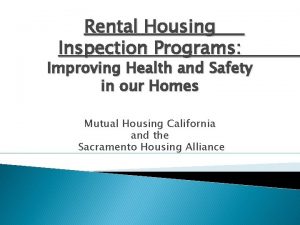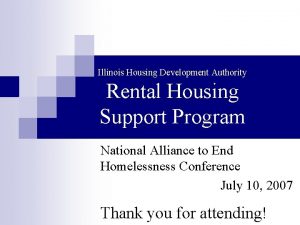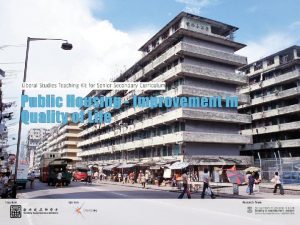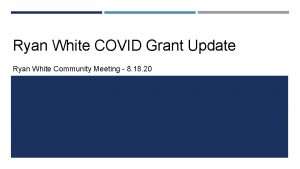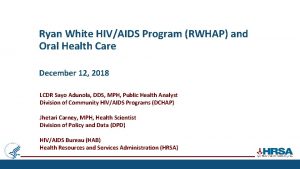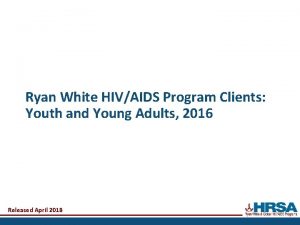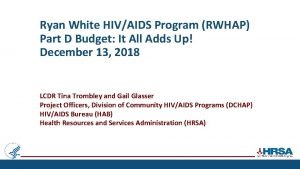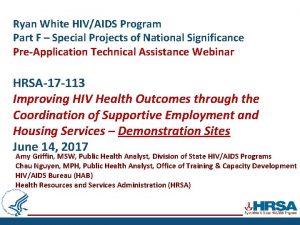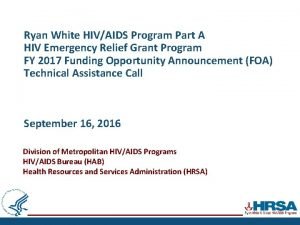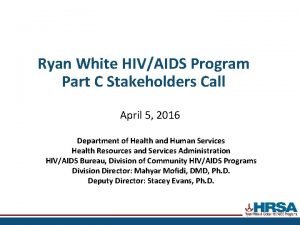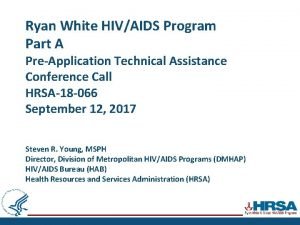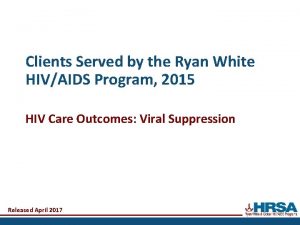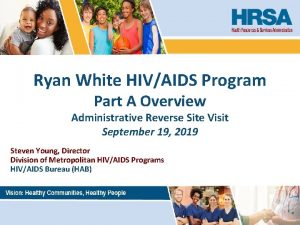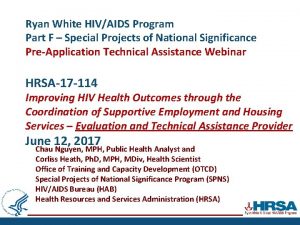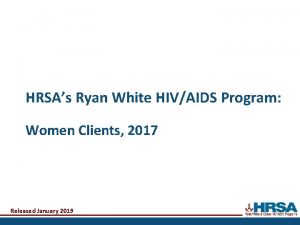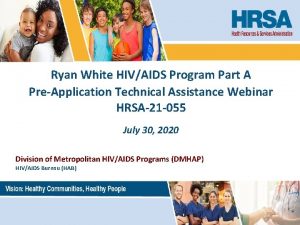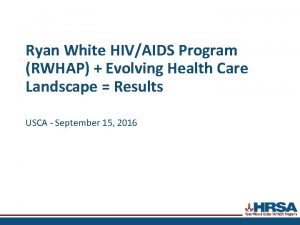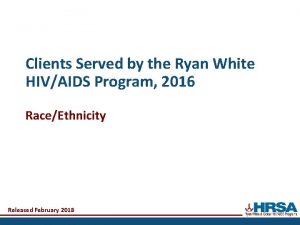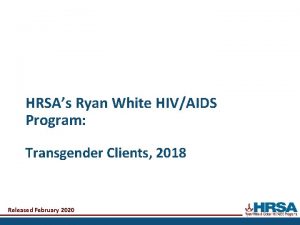OPERATIONAL PLAN RYAN WHITE HIVAIDS PROGRAM AND HOUSING




















- Slides: 20

OPERATIONAL PLAN RYAN WHITE HIV/AIDS PROGRAM AND HOUSING OPPORTUNITY FOR PEOPLE LIVING WITH HIV/AIDS HOUSING PROGRAM DATA INTEGRATION JANUARY 9, 2017

D. I. G Project Goals Enact new policies and processes to support data exchange and analysis; Create a bi-directional interface between the CAREWare and Case. Worthy systems; Develop and implement a cross training curriculum to foster improved service delivery, data exchange and analysis; Analyze comprehensive data to assess changes in health outcomes; Document and disseminate challenges, lessons learned, best practices, and innovative models. Improve health outcomes for persons living with HIV/AIDS and those prone to homelessness

Client Population Ryan White Part A Hartford HIV population & Hartford HOPWA clients who receives services in: Hartford County Middlesex County Tolland county.

Data Systems Ryan White CAREWare System (JPROG Inc. ) HOPWA Case. Worthy System (Nutmeg Consulting)

Key Partners City of Hartford Ryan White and HOPWA recipient Offices Human Resource Agency of New Britain, AIDS CT, Latinos Community Services, Connecticut Children’s Specialty Group, Mercy Housing and Shelter, Community Health Center Inc Rockville Hospital, Chrysalis Center, Hospital of Central Connecticut, Community Health Services Inc Hartford Hospital Charter Oak Health Center, Saint Francis Hospital, Community Renewal Team, St Phillips House, Hartford Gay and Lesbian Health Collective, University of Connecticut Health Center Hands on Hartford, Zezzo House

Data Integration Grant Steering Committee Peta-Gaye Nembhard Melissa Lebron Angelique Croasdale Danielle Warren-Diaz John Merz Yolanda Potter Melanie Alvarez Shawn Lang Lionel Rigler Catellia Casey Russ Cormier Abbie Kelly Kate Bassett Luna Jayna Hernandez Barbara Shaw Michelle Jarvis Sheryl Horowitz Ricardo Cruz

Data Elements

Interface Bidirectional Daily Imports/Exports of new data (if data is available) Case. Worhy will export housing data CAREWare will export Clinical and service Information into Case. Worthy Housing status, veterans status, financial assessment, CM assignment etc Medications, Labs, screenings, referrals, services, etc Alert/messaging system that allows users to send communications between systems

Reporting Performance Measurement Gaps in Care; Clients Prescribed HAART; Retention in Care and; Viral Load suppression. Custom Reporting demographics, service plan, housing data, referrals, utilization HOPWA CAPER (Improved) Ryan White RSR (Improved)

Client Flow Diagram CURRENT RYAN WHITE AND HOUSING SERVICE DELIVERY SYSTEM



Monitoring &Evaluation BY SHERYL HOROWITZ CHIEF RESEARCH AND EVALUATION OFFICER CONNECTICUT ASSOCIATION FOR HUMAN SERVICES

Research Question 1. How have client housing, care, and treatment outcomes for HOPWA and RW clients changed since both programs' providers began accessing integrated client data? Are changes equitable ? Data Source Outcome Measures RSR/CAPER element Housing Status: RSR • • % of RW clients unstably housed (disaggregated by race) % of HOPWA clients unstably housed (disaggregated by race) • Housing. Status. ID • Race/Ethnicity CAPER • % of consumers with joint RW and HOPWA needs who achieve both viral suppression (or are engaging in ART)and stable housing (including transitional or emergency) within 4 months of receipt of case management • • Retention in Care: • • Sites’ integrated data systems • RSR % of RW and HOPWA clients who had at least one HIV medical care visit in each six -month period over the last 12 months, with a minimum of 60 days between medical visits(disaggregated by race) % of new HOPWA clients who had at least one HIV medical care visit in each sixmonth period over the last 12 months, with a minimum of 60 days between medical visits (disaggregated by race) ART Use: Housing Status Type of Residence/Living Situation Race/Ethnicity Client. Report. Service Visits (Service. ID) Client. Report. Service Delivered (Service. ID) Client. Report. Ambulat Baseline, 6 m, ory. Service 12 m (Service. Date) Race/Ethnicity RSR % of RW and HOPWA clients prescribed ART for the treatment of HIV over the Prescribed. Art. ID previous 12 months (disaggregated by race) Race/Ethnicity • % of new HOPWA clients prescribed ART for the treatment of HIV over the previous 12 months(disaggregated by race) Viral suppression: RSR • • • Data Collection Intervals* % of RW and HOPWA clients with a viral load <200 copies/m. L during the last test in Client. Report. Viral. Loa the last 12 months(disaggregated by race) d. Test (Viral. Load. Test % of new HOPWA clients with a viral load <200 copies/m. L during the last test in the Count last 12 months(disaggregated by race) Service. Date) Race/Ethnicity

Research Question 2: In what ways has Ryan White and HOPWA data integration changed client service coordination across Ryan White and HOPWA providers? Data Source Outcome Measures RSR/CAPER element RW documentation of Housing Status: RSR • • Housing. Status. ID CAPER • # sites for which RW recipient has implemented collection of HOPWA housing status % of RW clients with housing status updated by RW MCM at least once in the last six months • • Housing Status Type of Residence/Living Situation Joint RW and HOPWA clients: CAPER • % of RW clients who are also HOPWA clients (have RW and HOPWA ID) • • # of RW clients who become new HOPWA clients # of RW and/or HOPWA clients with Gaps in Care Personal ID Project Entry Date Hartford-Data Interface • Sites’ integrated data systems Custom Report Coordination of new unstably housed RW clients: RSR • • Housing. Status. ID CAPER • • • Average amount of time between date of entry of unstable client housing status into RW data system and date of HOPWA intake/enrollment Average amount of time between date of entry of unstable client housing status into RW data system and date of placement into stable housing Mean referrals/client/quarter (RW to housing services and HOPWA to RW) # Custom reports generated/site with RW and HOPWA variables Data Collection Intervals* • • Housing Status Type of Residence/Living Situation Project Entry Date Destination Residential Move-In Date Referral type Custom Report Generation Baseline, 6 m, 12 m

Research Question 2: In what ways has Ryan White and HOPWA data integration changed client service coordination across Ryan White and HOPWA providers? (Cont’d) RAND TA logs / Site progress reports • • • RW and HOPWA program coordination # of RW and HOPWA joint program coordination meetings # of RW and HOPWA joint trainings • Perceived process of service coordination under old vs. new system List and descriptions of perceived barriers and facilitators List and descriptions of perceived effects of data integration and service protocol on coordination and client outcomes RW and HOPWA leadership, staff, • provider, and expert client • qualitative interviews • • 6 m, 12 m Yr 2 and Yr 3 annual site visits • • Observation of provider use of the • integrated data system • Provider quantitative survey Ability to use integrated data system to coordinate client services % of RW providers with housing-needs consumers, who request HOPWA data fields and reports/quarter % of HOPWA providers, with HIV/AIDS – needs consumers, who request RW data fields and reports/quarter # of requests for additional fields or information within database • % of staff with training who input data on a monthly basis • • Extent of use of the integrated data system Potential barriers to and facilitators of use (e. g. , regarding training and positive and negative beliefs about the system). % Very Satisfied with training % of providers satisfied with data integration product and procedures • • Yr 2 and Yr 3 annual site visits

Research Question 3: What specific aspects of data system changes (e. g. , flags, alerts, provider-to-provider communication) have affected client housing, care, and treatment outcomes? Data Source Outcome Measures Number and type of new data elements in integrated data systems: • Sites’ integrated data system documentation: • • • Codebooks/user manuals • for RW and HOPWA data systems • New data system functions (e. g. , flags, alerts) • • RW and HOPWA leadership, staff, and provider qualitative interviews • • Client focus groups or surveys • RSR/CAPER element New data fields for housing in RW data system and/or new data fields for care and treatment in HOPWA data system New provider referral or communication functions in data system Prompts to contact RW clients who are out of care Prompts to contact HOPWA clients who are out of care Prompts for RW providers to check housing information Prompts for HOPWA providers to check care and treatment outcomes Baseline, 6 m Reported use of novel data elements and data system functions Perceived adequacy of training on data system and service coordination changes Perceived positive and negative aspects of use Perceived change in quality of service Perceived change in personal and medical progress Perceived change in value of process Data Collection Intervals* Yr 2 and Yr 3 annual site visits

Research Question 4: In terms of cost, what resources are required to implement and maintain data integration of Ryan White and HOPWA data systems? Data Source Outcome Measures Site invoices • Financial data • Startup investment needed to launch the data integration Resources required to maintain the data integration Resources spent by categories of data integration activity Average cost of data integration per client served Staff time spent in labor categories (e. g. , training, service coordination, supervision, reporting, etc. )(disaggregated by staff tenure) • Annual RW and HOPWA leadership and staff survey • • RSR/CAPER element Data Collection Intervals* Monthly Yr 2 and Yr 3 annual site visits Hartford Research Question 5: What factors impact the implementation and efficiency of the integration of the Ryan White and HOPWA data systems? Data Source Outcome Measures • • Sites’ integrated data systems • RSR/CAPER element % of files w/o missing data elements Time from client event to data upload and availability (timeliness of data) % of clients who provide consent to RW and HOPWA • Knowledge and confidence with new policies and procedures Identified barriers Identified “Best Practices” Data Collection Intervals* System reports Monthly • Coordination meetings/staff • and leadership survey • Yr 2 and Yr 3 annual site visits

Training AIDS CT Joint HOPWA & Ryan White Monthly CM Training Full Day Case Manager Training – January 24, 2017 Joint HOPWA & Ryan White End User Training – Tentatively February 2017

Thank You Peta-Gaye K. Nembhard, MS BA City of Hartford Dept. Health and Human Services DIG Project Coordinator 860 -757 -4705 nembp 001@Hartford. gov
 Ryan white elite
Ryan white elite Ryan white
Ryan white Modular complexes texas
Modular complexes texas Flight operational quality assurance program
Flight operational quality assurance program Issa mood meaning
Issa mood meaning Ellen g white henry nichols white
Ellen g white henry nichols white Operating plan example
Operating plan example Operational planning template
Operational planning template Saps operational plan
Saps operational plan Synoptic approach in police planning
Synoptic approach in police planning Operational risk management plan template
Operational risk management plan template Single family housing section 504 repair pilot program
Single family housing section 504 repair pilot program City of sacramento rental housing inspection program
City of sacramento rental housing inspection program Hano housing choice voucher program
Hano housing choice voucher program Patterns behavioral services howell mi
Patterns behavioral services howell mi Usda linc training and resource library
Usda linc training and resource library Illinois rental housing support program
Illinois rental housing support program Fdic affordable housing program
Fdic affordable housing program Upper ngau tau kok estate
Upper ngau tau kok estate Affirmative fair housing marketing plan sample
Affirmative fair housing marketing plan sample Red orange yellow green blue purple pink black whi
Red orange yellow green blue purple pink black whi












